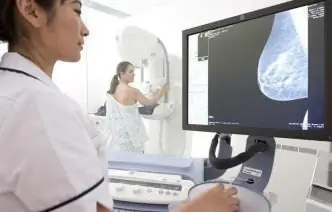Table of contents:
- Intraductal papilloma of the mammary gland
- General information
- The reasons
- Stages
- Symptoms
- Diagnostics
- Treatment of intraductal papilloma of the breast
- Prevention
- Video

Video: Intraductal Papilloma Of The Breast: Symptoms, Treatment, Surgery

2024 Author: Rachel Wainwright | [email protected]. Last modified: 2023-12-15 07:39
Intraductal papilloma of the mammary gland
The content of the article:
- General information
- The reasons
- Stages
- Symptoms
- Diagnostics
- Treatment of intraductal papilloma of the breast
- Prevention
- Video
Intraductal papilloma of the mammary gland (cystoadenopapilloma, cystadenoma) is one of the varieties of the proliferative form of fibrocystic mastopathy.
The disease is widespread. In the general structure of all benign neoplasms of the mammary glands, it accounts for 10%. The disease more often affects women in the premenopausal period. According to statistics, the average age of patients is 48 years.

Intraductal papilloma of the breast is a precancerous disease
General information
Intraductal papillary neoplasias are benign papillary growths originating from epithelial cells of the lactiferous ducts. The development of formations can be observed in any part of the ductal system, that is, from the terminal duct-lobular unit to the nipple.
Depending on the place of localization, there are:
- peripheral papillomas - often multiple in nature;
- central - usually located in the subareolar zone.
According to the features of the histological structure, tumors are divided into:
- benign;
- atypical;
- malignant (intracystic and intraductal papillary cancer).
Macroscopically, cystadenopapillomas look like cystic formations with papillary outgrowths (see photo). They are easily damaged even with minor mechanical influences on the mammary gland. At the same time, a bloody fluid is released, which enters the milk ducts and is removed from the nipple to the outside.
In tumor tissues, foci of necrosis and hemorrhage often occur. Malignant transformation is more often observed in patients with multiple intraductal papillomas of the mammary gland.
The reasons
The main cause of cystadenomas is hormonal imbalance, which can be provoked by:
- adnexitis;
- oophoritis;
- obesity;
- diabetes;
- abortion;
- severe stress.
In most cases, the development of cystadenopapilloma is preceded by diffuse or nodular fibrocystic mastopathy. This pathology is accompanied by the expansion of the milk ducts, in which papillary growths appear in the future.
The risk group for the development of the disease includes smokers and / or nulliparous women. Much less often, the pathology develops in patients who have children and breastfeed them, as well as in women taking oral contraceptives. The risk of developing cystoadenopapilloma is high in women whose close relatives have suffered from benign or malignant breast diseases.
Stages
During the tumor process, several stages are distinguished:
| Stage | Description |
| I | It is characterized by tissue hyperplasia. In terms of morphological structure, cells remain similar to normal cells, but functionally differ significantly from them. The size of the tumor at this stage usually does not exceed a few mm, and therefore, in most cases, neoplasms are not detected. |
| II | As the tumor grows, its structure changes. Small spaces begin to appear in it, which are filled with cell secretions. At this stage, patients may experience the first clinical symptoms of a tumor process. |
| III | Dysplasia (pathological changes) of cells increases. Not only their functioning changes, but also the morphological structure. |
| IV |
The tumor acquires the ability to grow into surrounding tissues and metastasize, which indicates the transformation of a benign neoplasm into a malignant one (malignancy). |
Symptoms
Intraductal papilloma has not been clinically manifested for quite a long time. There are no external changes in the skin and the shape of the mammary glands. In most cases, the first symptom of the disease is the appearance from the nipple of discharge of various colors (transparent, green, red). Many women experience soreness in the area of tumor localization, which is aggravated by wearing tight clothes, an incorrectly fitted bra.
When localized in the periareolar region, the tumor can be palpated as a small nodule of elastic consistency.
In some cases, papilloma in the mammary gland can become inflamed, which is clinically manifested by the appearance of the following symptoms:
- sharp soreness of the mammary gland;
- increased body temperature;
- redness of the skin in the projection of the neoplasm;
- an increase in the volume of the mammary gland, which is associated with tissue edema;
- change in the consistency and color of the discharge.
Diagnostics
Diagnosis of cystadenoma is based on the examination of the patient, the results of laboratory and instrumental examination methods, including:
- Cytological examination of the discharge from the nipple. If atypical cells are found, the patient must be referred to an oncologist.
- Determination of the CA 15-3 tumor marker. This analysis allows you to exclude malignant transformation of the tumor.
- Ductography (galactography). The milk ducts are filled with a special X-ray contrast agent, after which an X-ray examination is performed. This method allows the surgeon to assess the size and location of papillary growths. This is a very important study for developing a plan for surgical intervention.
- Ultrasound and MRI of the mammary glands, mammography. These types of instrumental studies do not provide visualization of the lactiferous ducts, however, they make it possible for a specialist to make a differential diagnosis of cystadenoma from a malignant tumor.

Mammography is done to detect or rule out breast cancer
Treatment of intraductal papilloma of the breast
Epithelial papillary outgrowths of the milky ducts belong to precancerous conditions, therefore, only surgical tactics are indicated for them.
The operation to remove cystadenomas is called sectoral breast resection. Most often, it is performed through the periareolar access, since the shape and size of the breast practically does not change, and the woman does not have to resort to mammoplasty in the future.
The removed tissues are sent for histological examination. If, according to its results, the patient is diagnosed with papillary cancer, then a radical mastectomy with subsequent hormonal, radiation and / or chemotherapy is necessary.
Prevention
In order to prevent the occurrence of intraductal papilloma of the mammary gland, women are recommended:
- conduct a monthly mammological self-examination;
- be regularly monitored by a mammologist and carry out the treatment of fibrocystic mastopathy as prescribed;
- timely treat dyshormonal and inflammatory diseases of the genital area.
Video
We offer for viewing a video on the topic of the article.

Elena Minkina Doctor anesthesiologist-resuscitator About the author
Education: graduated from the Tashkent State Medical Institute, specializing in general medicine in 1991. Repeatedly passed refresher courses.
Work experience: anesthesiologist-resuscitator of the city maternity complex, resuscitator of the hemodialysis department.
Found a mistake in the text? Select it and press Ctrl + Enter.
Recommended:
Breast Cyst: Symptoms, Treatment, Causes

A breast cyst belongs to benign formations. Symptoms depend on the form. Treatment is often surgical
Lipoma Of The Breast - Symptoms, Diagnosis, Treatment

Breast lipoma - a benign tumor formed by the fatty tissue of the breast
Breast Cancer - Symptoms, Treatment, Prognosis

Breast cancer is the most common cancer in women. In treatment, a prerequisite, with the exception of the terminal stages, is the operation to remove breast cancer
Breast Reduction - Surgery, Reasons, Reviews

Breast reduction surgery is called reduction mammoplasty and is often performed to improve health
Breast Cancer Treatment - Diagnosis, Treatment, Rehabilitation. Leading Clinics In Israel

The effectiveness of breast cancer treatment depends on the size of the malignant tumor and the presence of metastases. Doctors identify drug and surgical treatment






